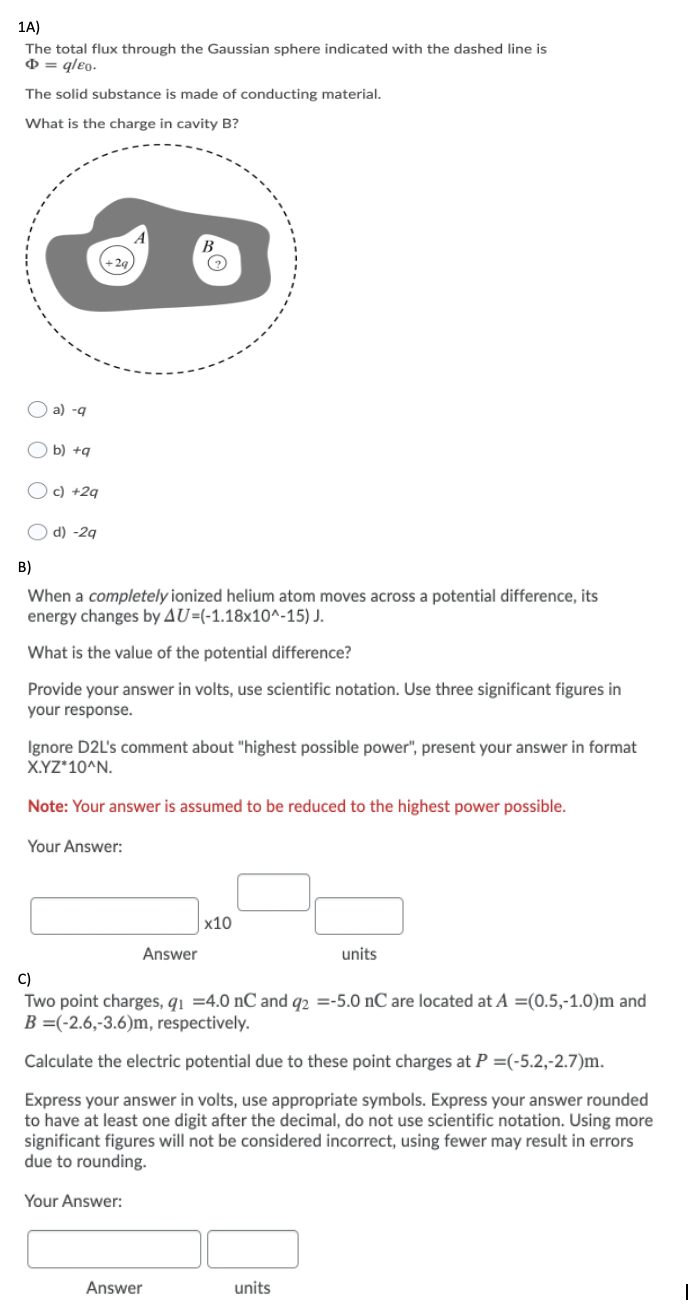The total flux through the Gaussian sphere indicated with the dashed line is $ = qleo- The solid substance is made of conducting material. What is the charge in cavity B? B +2g O a) -g O b) +g O c) +2q d) -2q
The total flux through the Gaussian sphere indicated with the dashed line is $ = qleo- The solid substance is made of conducting material. What is the charge in cavity B? B +2g O a) -g O b) +g O c) +2q d) -2q
Chapter6: Gauss's Law
Section: Chapter Questions
Problem 60P: An uncharged conductor with an internal cavity is shown in the following figure. Use the closed...
Related questions
Question

Transcribed Image Text:1A)
The total flux through the Gaussian sphere indicated with the dashed line is
0 = qleo-
The solid substance is made of conducting material.
What is the charge in cavity B?
O a) -g
b) +q
O c) +29
d) -2g
B)
When a completely ionized helium atom moves across a potential difference, its
energy changes by AU=(-1.18x10^-15) J.
What is the value of the potential difference?
Provide your answer in volts, use scientific notation. Use three significant figures in
your response.
Ignore D2L's comment about "highest possible power", present your answer in format
X.YZ*10^N.
Note: Your answer is assumed to be reduced to the highest power possible.
Your Answer:
х10
Answer
units
C)
Two point charges, q1 =4.0 nC and q2 =-5.0 nC are located at A =(0.5,-1.0)m and
B =(-2.6,-3.6)m, respectively.
Calculate the electric potential due to these point charges at P =(-5.2,-2.7)m.
Express your answer in volts, use appropriate symbols. Express your answer rounded
to have at least one digit after the decimal, do not use scientific notation. Using more
significant figures will not be considered incorrect, using fewer may result in errors
due to rounding.
Your Answer:
Answer
units
Expert Solution
This question has been solved!
Explore an expertly crafted, step-by-step solution for a thorough understanding of key concepts.
This is a popular solution!
Trending now
This is a popular solution!
Step by step
Solved in 2 steps

Knowledge Booster
Learn more about
Need a deep-dive on the concept behind this application? Look no further. Learn more about this topic, physics and related others by exploring similar questions and additional content below.Recommended textbooks for you


Physics for Scientists and Engineers, Technology …
Physics
ISBN:
9781305116399
Author:
Raymond A. Serway, John W. Jewett
Publisher:
Cengage Learning

College Physics
Physics
ISBN:
9781285737027
Author:
Raymond A. Serway, Chris Vuille
Publisher:
Cengage Learning


Physics for Scientists and Engineers, Technology …
Physics
ISBN:
9781305116399
Author:
Raymond A. Serway, John W. Jewett
Publisher:
Cengage Learning

College Physics
Physics
ISBN:
9781285737027
Author:
Raymond A. Serway, Chris Vuille
Publisher:
Cengage Learning

College Physics
Physics
ISBN:
9781305952300
Author:
Raymond A. Serway, Chris Vuille
Publisher:
Cengage Learning

Principles of Physics: A Calculus-Based Text
Physics
ISBN:
9781133104261
Author:
Raymond A. Serway, John W. Jewett
Publisher:
Cengage Learning

Physics for Scientists and Engineers
Physics
ISBN:
9781337553278
Author:
Raymond A. Serway, John W. Jewett
Publisher:
Cengage Learning